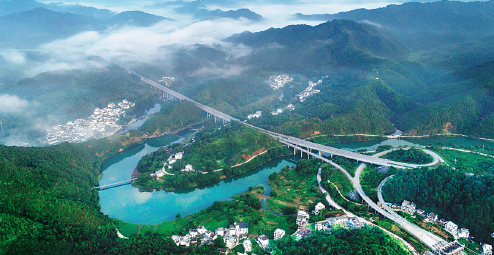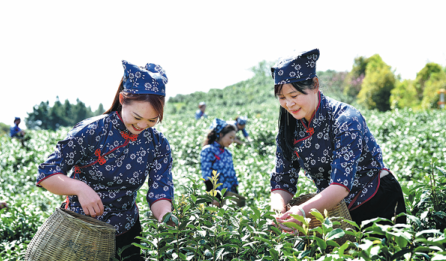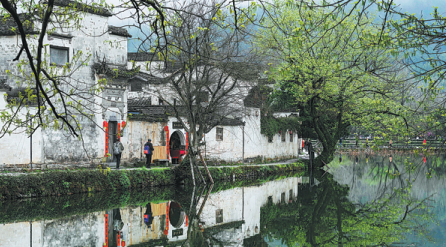A way and a 'Y' to go




A highway is transforming transportation and, consequently, tourism in East China
The ancient Chinese character qu, meaning roads reaching all directions, has been retained not only in contemporary language but also in its meaning.
It appears, for instance, in the centuries-old name of Quzhou city in East China's Zhejiang province, which neighbors Anhui, Jiangxi and Fujian provinces, because the city serves as a gateway to these regions.
But today few settlements big or small aren't connected by expressways, even in mountainous regions in places like Anhui, Jiangxi and Zhejiang.
Since its completion in 2006, the roughly 150-kilometer Jingdezhen-Wuyuan-Huangshan (Changshan) Expressway has served as a main route connecting Jiangxi's Jingdezhen city and Wuyuan county, Anhui's Huangshan city and Changshan county in Zhejiang's Quzhou.
The Y-shaped expressway leads from Jingdezhen in the west, which is celebrated as China's "porcelain capital", and bifurcates in Wuyuan toward Huangshan in the northeast and toward Changshan in the southeast.
"The expressway was the first of its kind in Wuyuan and has put the county on the fast track for development," said Shan Changhua, an information official of Wuyuan's Party committee.
The county received over 23 million tourist visits in 2019, generating 20 billion yuan ($3 billion) in revenue, the local government reports.
In 2008, Anhui extended the expressway by about 50 kilometers inside Huangshan city, which is famous for Huangshan Mountain, or Yellow Mountain, which is listed as a UNESCO Cultural and Natural Heritage and a Global Geopark.
Local officials said the city's tourism sector started booming in the 1980s, after the country's then leader Deng Xiaoping, who initiated the reform and opening-up in 1978, visited Huangshan Mountain in July 1979.
"The visit was considered the beginning of China's modern tourism development," said Fang Ying, deputy head of Huangshan's culture and tourism bureau.
About 104,000 people visited the mountain in 1979. That number could be exceeded in just two days during the busy season before the COVID-19 outbreak.
Increasingly convenient transportation has brought more travelers to areas across Huangshan.
Xidi and Hongcun villages, which are about 18 kilometers apart in Huangshan city's Yixian county, are jointly listed as a UNESCO Cultural Heritage Site and are colloquially referred to as "the country's most beautiful villages", thanks to their natural landscapes and ancient buildings.
The plates of the cars and buses that pack their major parking areas-Xidi's has about 1,200 parking spots and Hongcun's has about 1,500-reveal most vehicles are from nearby provinces, such as Zhejiang and Jiangxi.
The villages are known for their histories and preserved residences built in the Ming (1368-1644) and Qing (1644-1911) dynasties.
Delicate carvings
The houses are typical Huizhou-style architectural marvels featuring delicate carvings on wood, brick and stone. Many were built by ancient Huizhou merchants. Huizhou prefecture was the old name of Huangshan city, which governs Yixian.
Heritage-protection authorities said the city now has more than 8,000 ancient Huizhou-style houses.
"It's because Huangshan is a mountainous region that was seldom disturbed by wars that its ancient houses could be much better preserved than other areas of the country," said Hu Weimin, marketing manager of Yixian Huihuang Tourism Group, which runs 13 of the county's 17 major tourism attractions.
This is reflected by the fact that the city's forest coverage exceeds 80 percent.
The buildings' elaborate interior carvings contrast with the simple and clean white exterior walls and gray roof tiles.
"In early April, when the ancient villages are surrounded by yellow canola flowers, the scenery is very much like a watercolor painting," said Hu.
The scenery also attracts thousands of art students, Hu said.
And these landscapes are similar to those found in Jiangxi's Wuyuan county.
In ancient times, Huizhou prefecture governed one urban area and six rural counties, including Yixian and Wuyuan.
Wuyuan became a part of Jiangxi province in 1949, shortly before the founding of New China.
"The expressway has also played an important role in keeping Huizhou's culture intact by enhancing exchanges between Huizhou's former jurisdictions," Hu said.
Contact the writers at zhulixin@chinadaily.com.cn.















